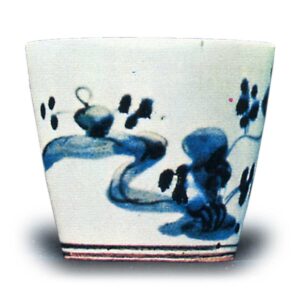
A small, deep ceramic vessel used for serving food. A ceramic sake cup with a small top opening and a narrow bottom. It is said that the character for “inokuchi” was copied from the Chinese character for “jong” (鍾) and is also said to be a transliteration of the Korean character for “jong pothole” (朝鮮鍾甌). The character for jong has been used for a long time, but the character for jong seems to have been first seen in the “Go-Sen Yigyoku-shu” of the Kanbun period (1661-173). It was first used in the food service section to serve shoyu, shiokara (salted fish), etc., and it was not until later that the term inokuchi was used to refer to small sake cups. Some types, such as the buckwheat noodle cups, were used to hold soup. As tableware, inokuchi were deep-shaped, as in the Satsuma dialect nosoki, and the most widespread type was the Hizen-Imari blue-glazed ones. There are two types of bases: one is glazed all over except for the outer ring of the base, and the other is called mekagami-zoko, in which the clay inside the base is exposed. Since so many pieces were required, there are many different patterns, but they all have the flavor of simplicity. For more information on sake cups, see the section on sake cups. (Go-sen-i Kyoku-shu, Nanru-betsu-shi, Wakan Sansai Zukai, Toga, Shiojiri, Urayu Shoran, and Joseon Ceramic Meikou)



